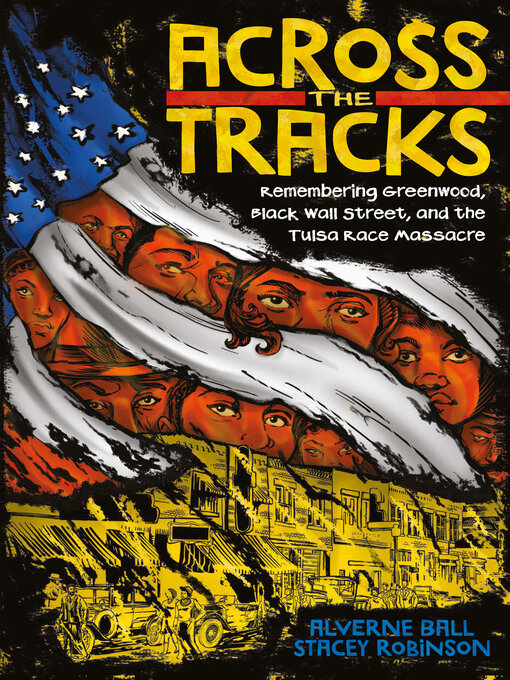Across the Tracks
Remembering Greenwood, Black Wall Street, and the Tulsa Race Massacre
In Across the Tracks: Remembering Greenwood, Black Wall Street, and the Tulsa Race Massacre, author Alverne Ball and illustrator Stacey Robinson have crafted a love letter to Greenwood, Oklahoma. Also known as Black Wall Street, Greenwood was a community whose importance is often overshadowed by the atrocious massacre that took place there in 1921.
Across the Tracks introduces the reader to the businesses and townsfolk who flourished in this unprecedented time of prosperity for Black Americans. We learn about Greenwood and why it is essential to remember the great achievements of the community as well as the tragedy which nearly erased it. However, Ball is careful to recount the eventual recovery of Greenwood. With additional supplementary materials including a detailed preface, timeline, and historical essay, Across the Tracks offers a thorough examination of the rise, fall, and rebirth of Black Wall Street.
-
Creators
-
Publisher
-
Release date
May 4, 2021 -
Formats
-
Kindle Book
-
OverDrive Read
- ISBN: 9781647003401
-
-
Languages
- English
-
Reviews
-
Booklist
April 15, 2021
Grades 8-11 Across the Tracks presents the largely buried story of Greenwood, Oklahoma, and the Tulsa massacre of 1921. For those who first heard about this history in HBO's Watchmen, this volume showcases fully just how much was destroyed. Greenwood, also known as Black Wall Street, originated as a neighborhood due to segregationist laws that prevented equal opportunity for Black people. However, those who lived in and built up the neighborhood turned this into an opportunity to start businesses, open theaters, and create services that catered to their Black neighbors. The pages are full of happy people going about their business in a way reminiscent of Norman Rockwell's wholesome paintings. Foreknowledge of the events--or the book's subtitle--lends tension and dread to every scene as the time line creeps up to the violence that killed 300 and left thousands homeless. Also included is an essay covering the history of the Tulsa area and the stake in it held by Black people and Indigenous nations. Focus on rebuilding efforts ends this brief but informative book on a hopeful note.COPYRIGHT(2021) Booklist, ALL RIGHTS RESERVED.
-
Publisher's Weekly
April 26, 2021
Ball and Robinson commemorate a grim anniversary in this salient account: 100 years since a white lynch mob killed at least 300 African Americans and destroyed 1,200 homes as they torched the Greenwood neighborhood of Tulsa, Okla., a thriving community Booker T. Washington dubbed Black Wall Street. Robinson’s bright artwork showcases the vibrancy of Greenwood, the pages spilling over with portraits of African American dentists, barbers, doctors, bus drivers, seamstresses, butchers, and chefs. “Now more than ever before it feels necessary to shine a light on the people that once lived in Greenwood,” Ball writes, calling to attention the timely publication. After the horrific events of the massacre, Ball ends the history on a note of perseverance, with residents determined to rebuild. With fewer than 50 pages of story line, it offers a glimpse into the past, but the straightforward narrative is notably devoid of, for example, quotes from survivors or their descendants. An essay by scholars Reynaldo Anderson and Colette Yellow rounds things out and provides crucial context. Educational and accessible, this feels well crafted for any American history class, or as a primer for general readers unfamiliar with this dark chapter of American history. -
School Library Journal
Starred review from September 3, 2021
Gr 6 Up-This nonfiction graphic novel shares an important, often overlooked piece of American history-the 1921 Tulsa race massacre. The community of Greenwood, in Tulsa, OK, in the early 1900s, also known as Black Wall Street, flourished even in the height of Jim Crow, with Black-owned businesses and cultural institutions. Wealthy businessman O.W. Gurley purchased land in Tulsa with a vision of creating a vibrant Black community. There he set up a grocery store and housing, as well as a church, a library and a community center. Separated from white communities by train tracks, residents of Greenwood continued to keep their business-and money-within Greenwood. When a Black man was accused of assaulting a white woman, a mob came to Greenwood to lynch him. Fighting ensued, and after a gun went off, the white mob was sanctioned by the sheriff of Tulsa to invade and destroy the town. What followed was a horrific destruction of property and massacre. Bold, full-color art enhances the enlightening text. The information is presented in a clear and accessible way; a preface and time line are included at the beginning, and an essay concludes the book. Back matter includes notes and sources. VERDICT This short yet powerful, nonfiction graphic novel is an essential purchase for all public and school libraries.-Marissa Lieberman, Cranford P.L., NJ
Copyright 2021 School Library Journal, LLC Used with permission.
-
subjects
Languages
- English
Loading
Why is availability limited?
×Availability can change throughout the month based on the library's budget. You can still place a hold on the title, and your hold will be automatically filled as soon as the title is available again.
The Kindle Book format for this title is not supported on:
×- - Kindle 1
- - Kindle 2
- - Kindle DX
- - Kindle Keyboard
- - Kindle 4
- - Kindle Touch
- - Kindle 5
- - Kindle Paperwhite
- - Kindle 7
- - Kindle Voyage
Read-along ebook
×The OverDrive Read format of this ebook has professional narration that plays while you read in your browser. Learn more here.



